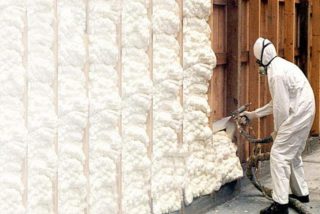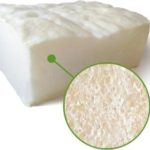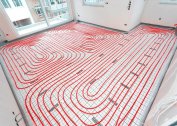Foam insulation is a worthy and effective analogue of the slab, roll and bulk type. These materials have an acceptable cost, a sufficient service life, but can not be compared with polyurethane according to the main criteria that affect the speed of construction and the quality of living in finished objects. Despite certain difficulties associated with the application of foam insulation for walls, the costs are repeatedly paid off due to the high performance characteristics of this technology. If you want to perform wall insulation with foam, you can do it yourself, saving on the services of professionals. To do this, you need to purchase special equipment and learn how to use it. This is a promising investment, as equipment may be required several times to insulate old or newly built buildings on the site - a barn, a garage, a workshop, a barn, a bathhouse, a cellar. For the work to be done at the proper technological level, you need to understand the features of the software and the rules for its application.
Material Features
Wall insulation foam is an innovative material that has been developed literally in the last decade. It is used relatively rarely, as consumers relate to it with caution, due to the specificity, novelty and unusualness. An important factor is that to apply thermal insulation material in large volumes is possible only with the help of industrial equipment. In remote regions, this service is not yet available.
Foam insulation has the following advantages:
- Low thermal conductivity. This indicator is currently the best, surpassing even the popular foam foam among installers.
- Speed of application. If we put aside the services of wage workers, all other heaters are not comparable here. Foam insulation is much faster than other materials. The main thing is not to equal the cost.
- Long term of operation. PPU has a minimum of 50 years of service. Since this is a new tool that has not yet been investigated, this period is calculated. As observations show, the insulation does not change its characteristics during the warranty period.
- Tightness. After applying to the facade, the foam envelops it with a continuous layer, which does not allow moisture, heat and cold. The dew point is shifting, the supporting structure is not exposed to negative weather factors.
- Biological inertness. The most common thermal insulation product, Polynor, is immune to microorganisms and is avoided by animals and insects.
- Vapor permeability. An indispensable property when warming wooden buildings, where the main condition is natural ventilation.
Foam insulation penetrates into any inaccessible places and completely fills all the voids. This eliminates the possibility of skipping untreated areas during the insulation of the roof with polyurethane foam. This property is also useful in terms of combating nests of birds and insects. Living things simply cannot find a suitable place to settle.
A significant drawback of the material is its low resistance to ultraviolet radiation. With prolonged exposure to the sun, the foam darkens, hardens and crumbles. Based on this, the applied coating must be immediately closed.
What objects is foam used for?
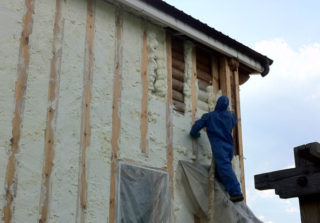
Penoizol is very popular in large cities, where the warming of residential and administrative buildings is given priority. Depending on the characteristics of the processed objects, spraying is carried out from the inside or outside.
For processing facades, a special wall composition is used, which is characterized by increased adhesion, density and resistance to temperature extremes. Foam is applied from bottom to top, in layers of 2-3 cm thick each. It is economically unprofitable to use disposable cans for wall insulation. One capacity of 1000 ml is only enough to cover 1 square meter. meters with a layer 4 cm thick. It is advisable to make such a decision when you need to insulate a small area of the surface - niches, large gaps, stairs and other small objects. For wall insulation, it is better to attract a team with special equipment. The choice of insulation is determined by the composition of the walls. For concrete, a substance that forms closed cells is better suited. For structures made of wood, brick and aerated concrete, it is advisable to use foam with open cells that allow air to pass through.
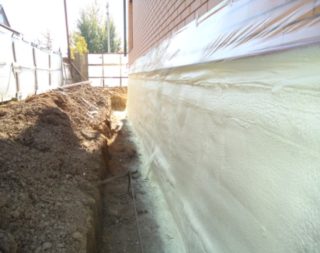
For small work on the balcony and loggia it is better to use cans. Apply foam to insulate the floor, walls and ceiling from the inside. The polynor is applied inside the crate, which is then sheathed with solid material. Even filling the opening of the fire hatch with foam is not a violation, since it easily leaves the hole with little pressure.
When installing or repairing windows, it is advisable to expand the openings and fill them with foam, followed by sealing with plaster. Since the porous substance is characterized by low thermal conductivity, the openings will effectively retain external cold and heat.
Polyurethane foam is widely used in the construction industry. At the initial stage of building construction, applying an insulating layer to the foundation is practiced. Thanks to this solution, the base is reliably protected from damp and cold soil freezing in winter. In addition, the foam does not allow alkalis in the soil to pass to concrete, which helps to extend the life of the building. At the final stage of construction, the roof is insulated with foam. This solution helps create a comfortable microclimate in the attics and upper floors of houses.
Demanding foam in the arrangement of pipeline systems. Warming lines with this substance is much faster, cheaper and more practical than traditional mineral wool. After solidification, the foam becomes one with the pipes, protecting them from cold, corrosion and external pressure.
Varieties of insulation foam
When deciding whether to insulate the house with foam, it is necessary to choose the material that most fully meets the requirements for the object to be insulated. On sale you can find semi-professional (household) and professional means for warming objects of various types and sizes.
Polyurethane foam
It belongs to the category of household products made on the basis of polyurethane. One-component liquid solution is in ordinary steel cans, the capacity of which is 500-2000 ml. 5-20 l of foam is produced depending on the volume.
Leaving the nebulizer, the solution enters into a chemical reaction with air, increases in volume and solidifies after 20-30 minutes, forming a dense spongy substance. The substance conducts air well, as a result of which polyurethane foam is in demand for the arrangement of wooden buildings. Foam application is carried out in one step without intermediate layers, which positively affects the speed of work. You can use cans to perform small one-time operations associated with the low consumption of foamy substance.
Two-component polyurethane foam
The two-component insulation composition is the most effective among the analogues of the foam group. The advantages are in the speed of application of the substance and in its operational characteristics. The defoamer in cylinders is delivered to the site where the containers are connected to the air compressor. When mixing the components, an instant reaction begins, accompanied by the release of carbon dioxide, forming a foam. After solidification, a porous substance is formed, 90% of which consists of gas. Closed cells exclude wet insulation, including with prolonged exposure to damp. At the same time, the material retains ventilation properties, ensuring the removal of steam from the premises.
After hitting the surface, the mixture increases in volume by 40 times, which ensures high pressure and penetration of insulation into all voids, recesses and crevices. This property must be taken into account when filling up bottlenecks, as expanding foam can destroy brickwork or jam doors.
Penoizol
Penoizol belongs to the category of liquid heaters of the carbide group. The special composition of the substance makes it completely safe for human health and the environment. The material looks like foam and has high thermal insulation properties. Upon contact with fire, it melts without releasing toxic compounds. An interesting feature of penoizol is its rejection by insects and animals. They try to avoid the proximity to the insulation, despite its external attractiveness.
The material has low adhesion and almost zero secondary expansion. Based on this, its scope is quite limited. The porous structure allows moisture to pass through perfectly, which makes it possible to equip wooden houses with penoizol without losing their ventilation qualities. Due to the hygroscopicity of the foam, it cannot be applied to foundations, cellar walls, pipes and other objects in contact with wet soil.
- Two-component polyurethane foam
- Penoizol
- Polyurethane foam
How to spray polyurethane foam
The sprayed polyurethane foam consists of polyol and polyisocyanate. Both solutions are in sealed containers that connect to the compressor. The size and power of the equipment may vary, but they work on the same principle. After connecting the containers through hoses to the equipment, it is set up in accordance with the manufacturer's instructions for the insulation.
When the compressor is turned on, the pressure necessary to collect and pump the ingredients along the lines is created. Mixing is carried out in a nozzle that delivers a flow of foaming liquid to the surface. The mixture is characterized by excellent adhesion and rapid solidification. It must be applied from the bottom up, so that the material below it plays the role of an abutment for the next layers. Foam lays well on vertical walls and on surfaces with negative angles, such as the roof of the house and the attic. Moreover, the thermal insulation object does not need any preliminary preparation.
Penoizol filling
Penoizol is a derivative substance consisting of several components. Foam is prepared directly at the facility.
The following ingredients are added alternately to the container:
- water;
- foaming solution;
- acid;
- liquid synthetic resin.
When substances interact with each other, foaming of the solution occurs. The resin does not completely fall to it, which holds the air inside the bubbles. The polymerization process lasts 3 days and is accompanied by slight shrinkage up to 3% of the volume.
Since the foam does not expand after exiting the atomizer, filling the cavities does not occur due to the increase in volume, but due to the flow of fluid into them under the influence of gravity.To avoid the formation of voids in the thermal insulation layer, it is fed into the mold under high pressure, which ensures the filling of the entire internal space. For high-quality processing of objects you need to have good professional skills, equipment and carefully maintain the proportions of the components.
Since Penoizol is fluid and slowly solidifies, it is used to fill double walls, insulate floors or roofs using a membrane film as a formwork.
